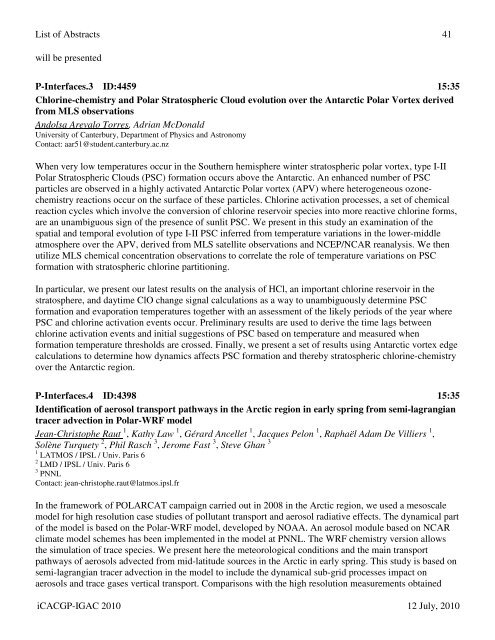Download Abstracts Here - IGAC Project
Download Abstracts Here - IGAC Project
Download Abstracts Here - IGAC Project
You also want an ePaper? Increase the reach of your titles
YUMPU automatically turns print PDFs into web optimized ePapers that Google loves.
List of <strong>Abstracts</strong> 41will be presentedP-Interfaces.3 ID:4459 15:35Chlorine-chemistry and Polar Stratospheric Cloud evolution over the Antarctic Polar Vortex derivedfrom MLS observationsAndolsa Arevalo Torres, Adrian McDonaldUniversity of Canterbury, Department of Physics and AstronomyContact: aar51@student.canterbury.ac.nzWhen very low temperatures occur in the Southern hemisphere winter stratospheric polar vortex, type I-IIPolar Stratospheric Clouds (PSC) formation occurs above the Antarctic. An enhanced number of PSCparticles are observed in a highly activated Antarctic Polar vortex (APV) where heterogeneous ozonechemistryreactions occur on the surface of these particles. Chlorine activation processes, a set of chemicalreaction cycles which involve the conversion of chlorine reservoir species into more reactive chlorine forms,are an unambiguous sign of the presence of sunlit PSC. We present in this study an examination of thespatial and temporal evolution of type I-II PSC inferred from temperature variations in the lower-middleatmosphere over the APV, derived from MLS satellite observations and NCEP/NCAR reanalysis. We thenutilize MLS chemical concentration observations to correlate the role of temperature variations on PSCformation with stratospheric chlorine partitioning.In particular, we present our latest results on the analysis of HCl, an important chlorine reservoir in thestratosphere, and daytime ClO change signal calculations as a way to unambiguously determine PSCformation and evaporation temperatures together with an assessment of the likely periods of the year wherePSC and chlorine activation events occur. Preliminary results are used to derive the time lags betweenchlorine activation events and initial suggestions of PSC based on temperature and measured whenformation temperature thresholds are crossed. Finally, we present a set of results using Antarctic vortex edgecalculations to determine how dynamics affects PSC formation and thereby stratospheric chlorine-chemistryover the Antarctic region.P-Interfaces.4 ID:4398 15:35Identification of aerosol transport pathways in the Arctic region in early spring from semi-lagrangiantracer advection in Polar-WRF modelJean-Christophe Raut 1 , Kathy Law 1 , Gérard Ancellet 1 , Jacques Pelon 1 , Raphaël Adam De Villiers 1 ,Solène Turquety 2 , Phil Rasch 3 , Jerome Fast 3 , Steve Ghan 31 LATMOS / IPSL / Univ. Paris 62 LMD / IPSL / Univ. Paris 63 PNNLContact: jean-christophe.raut@latmos.ipsl.frIn the framework of POLARCAT campaign carried out in 2008 in the Arctic region, we used a mesoscalemodel for high resolution case studies of pollutant transport and aerosol radiative effects. The dynamical partof the model is based on the Polar-WRF model, developed by NOAA. An aerosol module based on NCARclimate model schemes has been implemented in the model at PNNL. The WRF chemistry version allowsthe simulation of trace species. We present here the meteorological conditions and the main transportpathways of aerosols advected from mid-latitude sources in the Arctic in early spring. This study is based onsemi-lagrangian tracer advection in the model to include the dynamical sub-grid processes impact onaerosols and trace gases vertical transport. Comparisons with the high resolution measurements obtainediCACGP-<strong>IGAC</strong> 2010 12 July, 2010








